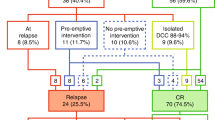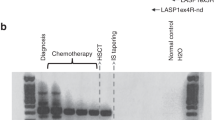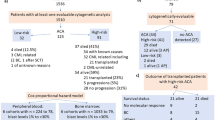Abstract
Real-time quantitative polymerase chain reaction (PCR) for BCR-ABL mRNA in the peripheral blood (RQ-PCR) provides an accurate and reliable measure of response to therapy in chronic myeloid leukaemia (CML). We wanted to determine in what circumstances additional clinically relevant information was provided by simultaneous cytogenetic analysis in RQ-PCR monitored patients receiving imatinib treatment. We analysed 828 simultaneous RQ-PCR and bone marrow cytogenetic analyses from 183 patients with chronic phase CML with a median follow-up of 20 months. Cytogenetic progression was defined as Philadelphia (Ph)-positive clonal evolution, loss of complete cytogenetic response or an increase of ⩾20% Ph-positive cells. Cytogenetic progression occurred in 24/183 (13%) patients. At the time of cytogenetic progression, none of the 24 patients had a major molecular response (MMR;⩾3-log reduction in BCR-ABL from standardised baseline). There were 320 RQ-PCR results from 95 patients indicating MMR. No abnormality was detected in any of the corresponding cytogenetic analyses. A policy of regular RQ-PCR monitoring with cytogenetic analysis targetted only to patients who have not achieved, or have lost MMR would represent a rational approach to monitoring and spare most patients the discomfort of multiple marrow aspirates. This approach depends upon availability of an accurate, reproducible RQ-PCR assay with ongoing quality assurance.
This is a preview of subscription content, access via your institution
Access options
Subscribe to this journal
Receive 12 print issues and online access
$259.00 per year
only $21.58 per issue
Buy this article
- Purchase on Springer Link
- Instant access to full article PDF
Prices may be subject to local taxes which are calculated during checkout

Similar content being viewed by others
References
Daley GQ, Van Etten RA, Baltimore D . Induction of chronic myelogenous leukemia in mice by the P210bcr/abl gene of the Philadelphia chromosome. Science 1990; 247: 824–830.
Kelliher MA, McLaughlin J, Witte ON, Rosenberg N . Induction of a chronic myelogenous leukemia-like syndrome in mice with v-abl and BCR/ABL. Proc Natl Acad Sci USA 1990; 87: 6649–6653.
Druker BJ, Tamura S, Buchdunger E, Ohno S, Segal GM, Fanning S et al. Effects of a selective inhibitor of the Abl tyrosine kinase on the growth of Bcr-Abl positive cells. Nat Med 1996; 2: 561–566.
O'Brien SG, Guilhot F, Larson RA, Gathmann I, Baccarani M, Cervantes F et al. Imatinib compared with interferon and low-dose cytarabine for newly diagnosed chronic-phase chronic myeloid leukemia. N Engl J Med 2003; 348: 994–1004.
Gorre ME, Mohammed M, Ellwood K, Hsu N, Paquette R, Rao PN et al. Clinical resistance to STI-571 cancer therapy caused by BCR-ABL gene mutation or amplification. Science 2001; 293: 876–880.
Branford S, Rudzki Z, Walsh S, Grigg A, Arthur C, Taylor K et al. High frequency of point mutations clustered within the adenosine triphosphate-binding region of BCR/ABL in patients with chronic myeloid leukemia or Ph-positive acute lymphoblastic leukemia who develop imatinib (STI571) resistance. Blood 2002; 99: 3472–3475.
Branford S, Rudzki Z, Walsh S, Parkinson I, Grigg A, Szer J et al. Detection of BCR-ABL mutations in patients with CML treated with imatinib is virtually always accompanied by clinical resistance, and mutations in the ATP phosphate-binding loop (P-loop) are associated with a poor prognosis. Blood 2003; 102: 276–283.
Shah NP, Nicoll JM, Nagar B, Gorre ME, Paquette RL, Kuriyan J et al. Multiple BCR-ABL kinase domain mutations confer polyclonal resistance to the tyrosine kinase inhibitor imatinib (STI571) in chronic phase and blast crisis chronic myeloid leukemia. Cancer Cell 2002; 2: 117–125.
Hochhaus A, Kreil S, Corbin A, La Rosee P, Lahaye T, Berger U et al. Roots of clinical resistance to STI-571 cancer therapy. Science 2001; 293: 2163.
Branford S, Hughes TP, Rudzki Z . Monitoring chronic myeloid leukaemia therapy by real-time quantitative PCR in blood is a reliable alternative to bone marrow cytogenetics. Br J Haematol 1999; 107: 587–599.
Wang L, Pearson K, Ferguson JE, Clark RE . The early molecular response to imatinib predicts cytogenetic and clinical outcome in chronic myeloid leukaemia. Br J Haematol 2003; 120: 990–999.
Merx K, Muller MC, Kreil S, Lahaye T, Paschka P, Schoch C et al. Early reduction of BCR-ABL mRNA transcript levels predicts cytogenetic response in chronic phase CML patients treated with imatinib after failure of interferon alpha. Leukemia 2002; 16: 1579–1583.
Hughes TP, Kaeda J, Branford S, Rudzki Z, Hochhaus A, Hensley ML et al. Frequency of major molecular responses to imatinib or interferon alfa plus cytarabine in newly diagnosed chronic myeloid leukemia. N Engl J Med 2003; 349: 1423–1432.
Kantarjian HM, Talpaz M, Cortes J, O'Brien S, Faderl S, Thomas D et al. Quantitative polymerase chain reaction monitoring of BCR-ABL during therapy with imatinib mesylate (STI571; gleevec) in chronic-phase chronic myelogenous leukemia. Clin Cancer Res 2003; 9: 160–166.
Lange T, Bumm T, Otto S, Al-Ali HK, Kovacs I, Krug D et al. Quantitative reverse transcription polymerase chain reaction should not replace conventional cytogenetics for monitoring patients with chronic myeloid leukemia during early phase of imatinib therapy. Haematologica 2004; 89: 49–57.
Muller MC, Gattermann N, Lahaye T, Deininger MW, Berndt A, Fruehauf S et al. Dynamics of BCR-ABL mRNA expression in first-line therapy of chronic myelogenous leukemia patients with imatinib or interferon alpha/ara-C. Leukemia 2003; 17: 2392–2400.
Hochhaus A, Lin F, Reiter A, Skladny H, Mason PJ, van Rhee F et al. Quantification of residual disease in chronic myelogenous leukemia patients on interferon-alpha therapy by competitive polymerase chain reaction. Blood 1996; 87: 1549–1555.
Branford S, Rudzki Z, Harper A, Grigg A, Taylor K, Durrant S et al. Imatinib produces significantly superior molecular responses compared to interferon alfa plus cytarabine in patients with newly diagnosed chronic myeloid leukemia in chronic phase. Leukemia 2003; 17: 2401–2409.
Kantarjian H, Talpaz M, O'Brien S, Garcia-Manero G, Verstovsek S, Giles F et al. High-dose imatinib mesylate therapy in newly diagnosed Philadelphia chromosome-positive chronic phase chronic myeloid leukemia. Blood 2004; 103: 2873–2878.
Talpaz M, Silver RT, Druker BJ, Goldman JM, Gambacorti-Passerini C, Guilhot F et al. Imatinib induces durable hematologic and cytogenetic responses in patients with accelerated phase chronic myeloid leukemia: results of a phase 2 study. Blood 2002; 99: 1928–1937.
Kantarjian HM, O'Brien S, Cortes JE, Smith TL, Rios MB, Shan J et al. Treatment of philadelphia chromosome-positive, accelerated-phase chronic myelogenous leukemia with imatinib mesylate. Clin Cancer Res 2002; 8: 2167–2176.
Cortes JE, Talpaz M, Giles F, O'Brien S, Rios MB, Shan J et al. Prognostic significance of cytogenetic clonal evolution in patients with chronic myelogenous leukemia on imatinib mesylate therapy. Blood 2003; 101: 3794–3800.
O'Dwyer ME, Mauro MJ, Kurilik G, Mori M, Balleisen S, Olson S et al. The impact of clonal evolution on response to imatinib mesylate (STI571) in accelerated phase CML. Blood 2002; 100: 1628–1633.
Majlis A, Smith TL, Talpaz M, O'Brien S, Rios MB, Kantarjian HM . Significance of cytogenetic clonal evolution in chronic myelogenous leukemia. J Clin Oncol 1996; 14: 196–203.
Medina J, Kantarjian H, Talpaz M, O'Brien S, Garcia-Manero G, Giles F et al. Chromosomal abnormalities in Philadelphia chromosome-negative metaphases appearing during imatinib mesylate therapy in patients with Philadelphia chromosome-positive chronic myelogenous leukemia in chronic phase. Cancer 2003; 98: 1905–1911.
Terre C, Eclache V, Rousselot P, Imbert M, Charrin C, Gervais C et al. Report of 34 patients with clonal chromosomal abnormalities in Philadelphia-negative cells during imatinib treatment of Philadelphia-positive chronic myeloid leukemia. Leukemia 2004; 18: 1340–1346.
Bumm T, Muller C, Al-Ali HK, Krohn K, Shepherd P, Schmidt E et al. Emergence of clonal cytogenetic abnormalities in Ph- cells in some CML patients in cytogenetic remission to imatinib but restoration of polyclonal hematopoiesis in the majority. Blood 2003; 101: 1941–1949.
Alimena G, Breccia M, Mancini M, Ferranti G, De Felice L, Gallucci C et al. Clonal evolution in Philadelphia chromosome negative cells following successful treatment with Imatinib of a CML patient: clinical and biological features of a myelodysplastic syndrome. Leukemia 2004; 18: 361–362.
Chee YL, Vickers MA, Stevenson D, Holyoake TL, Culligan DJ . Fatal myelodysplastic syndrome developing during therapy with imatinib mesylate and characterised by the emergence of complex Philadelphia negative clones. Leukemia 2003; 17: 634–635.
Eikelboom JW . RE: Bain BJ. (2004) Bone marrow biopsy morbidity and mortality: 2002 data. Clinical and Laboratory Haematology 26: 315–318. Clin Lab Haematol 2005; 27: 209–210.
Bain BJ . Bone marrow biopsy morbidity and mortality: 2002 data. Clin Lab Haematol 2004; 26: 315–318.
. National Pathology Accreditation Advisory Council Guidelines for Cytogenetic Laboratories. Australian Government Department of Health and Ageing: Canberra, 2001.
Mitelman F (ed). An International System for Human Cytogenetic Nomenclature. Karger: Basel, 1995.
Branford S, Hughes TP In: Iland HJ, Hertzberg M, Marlton P (eds). Myeloid Leukemia: Methods and Protocols, Methods in Molecular Medicine. Humana Press: Totawa, NJ, 2005.
Branford S, Rudzki Z, Parkinson I, Grigg A, Taylor K, Seymour JF et al. Real-time quantitative PCR analysis can be used as a primary screen to identify patients with CML treated with imatinib who have BCR-ABL kinase domain mutations. Blood 2004; 104: 2926–2932.
Wang L, Pearson K, Pillitteri L, Ferguson JE, Clark RE . Serial monitoring of BCR-ABL by peripheral blood real-time polymerase chain reaction predicts the marrow cytogenetic response to imatinib mesylate in chronic myeloid leukaemia. Br J Haematol 2002; 118: 771–777.
Wiktor A, Rybicki BA, Piao ZS, Shurafa M, Barthel B, Maeda K et al. Clinical significance of Y chromosome loss in hematologic disease. Genes Chromosomes Cancer 2000; 27: 11–16.
United Kingdom Cancer Cytogenetics Group (UKCCG). Loss of the Y chromosome from normal and neoplastic bone marrows. Genes Chromosomes Cancer 1992; 5: 83–88.
Maciejewski JP, Risitano A, Sloand EM, Nunez O, Young NS . Distinct clinical outcomes for cytogenetic abnormalities evolving from aplastic anemia. Blood 2002; 99: 3129–3135.
Maserati E, Aprili F, Vinante F, Locatelli F, Amendola G, Zatterale A et al. Trisomy 8 in myelodysplasia and acute leukemia is constitutional in 15–20% of cases. Genes Chromosomes Cancer 2002; 33: 93–97.
Najfeld V, Montella L, Scalise A, Fruchtman S . Exploring polycythaemia vera with fluorescence in situ hybridization: additional cryptic 9p is the most frequent abnormality detected. Br J Haematol 2002; 119: 558–566.
Paulsson K, Sall T, Fioretos T, Mitelman F, Johansson B . The incidence of trisomy 8 as a sole chromosomal aberration in myeloid malignancies varies in relation to gender, age, prior iatrogenic genotoxic exposure, and morphology. Cancer Genet Cytogenet 2001; 130: 160–165.
Fayad L, Kantarjian H, O'Brien S, Seong D, Albitar M, Keating M et al. Emergence of new clonal abnormalities following interferon-alpha induced complete cytogenetic response in patients with chronic myeloid leukemia: report of three cases. Leukemia 1997; 11: 767–771.
Casali M, Truglio F, Milone G, Di Raimondo F, Parrinello G, Maserati E et al. Trisomy 8 in Philadelphia chromosome (Ph1)-negative cells in the course of Ph1-positive chronic myelocytic leukemia. Genes Chromosomes Cancer 1992; 4: 269–270.
Hando JC, Nath J, Tucker JD . Sex chromosomes, micronuclei and aging in women. Chromosoma 1994; 103: 186–192.
Surralles J, Jeppesen P, Morrison H, Natarajan AT . Analysis of loss of inactive X chromosomes in interphase cells. Am J Hum Genet 1996; 59: 1091–1096.
Hanson L, Bryman I, Barrenas ML, Janson PO, Wahlstrom J, Albertsson-Wikland K et al. Genetic analysis of mosaicism in 53 women with Turner syndrome. Hereditas 2001; 134: 153–159.
Takeshita A, Shinjo K, Yamashita M, Fujisawa S, Naito K, Ohnishi K et al. Extensive cytogenetic studies of clonality following interferon-alpha therapy in chronic myeloid leukemia occurring in monosomic cells in a patient with Turner syndrome mosaic. Leukemia 1999; 13: 1749–1753.
Braziel RM, Launder TM, Druker BJ, Olson SB, Magenis RE, Mauro MJ et al. Hematopathologic and cytogenetic findings in imatinib mesylate-treated chronic myelogenous leukemia patients: 14 months' experience. Blood 2002; 100: 435–441.
McNamara C, Grigg A, Szer J, Roberts A, Campbell L, Hoyt R et al. Morphological effects of imatinib mesylate (STI571) on the bone marrow and blood of patients with Philadelphia chromosome (Ph) positive chronic myeloid leukaemia. Clin Lab Haematol 2003; 25: 119–125.
Acknowledgements
We thank Dr J Reynolds, Professor P Browett and other members of the Australasian Leukaemia and Lymphoma Group and Drs K Lynch and I Gathmann of Novartis Pharmaceuticals for their assistance in providing data from clinical trial patients.
Author information
Authors and Affiliations
Corresponding author
Rights and permissions
About this article
Cite this article
Ross, D., Branford, S., Moore, S. et al. Limited clinical value of regular bone marrow cytogenetic analysis in imatinib-treated chronic phase CML patients monitored by RQ-PCR for BCR-ABL. Leukemia 20, 664–670 (2006). https://doi.org/10.1038/sj.leu.2404139
Received:
Revised:
Accepted:
Published:
Issue Date:
DOI: https://doi.org/10.1038/sj.leu.2404139
Keywords
This article is cited by
-
What is the impact of failing to achieve TKI therapy milestones in chronic myeloid leukemia
Leukemia (2023)
-
Activated naïve γδ T cells accelerate deep molecular response to BCR-ABL inhibitors in patients with chronic myeloid leukemia
Blood Cancer Journal (2021)
-
Tyrosine Kinase Inhibitors in the Treatment of Chronic-Phase CML: Strategies for Frontline Decision-making
Current Hematologic Malignancy Reports (2018)
-
Detection of 22 common leukemic fusion genes using a single-step multiplex qRT-PCR-based assay
Diagnostic Pathology (2017)
-
Minimal Residual Disease Eradication in CML: Does It Really Matter?
Current Hematologic Malignancy Reports (2017)



